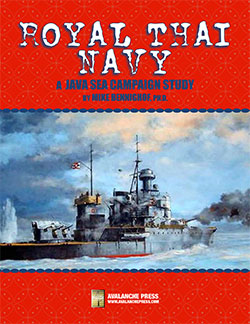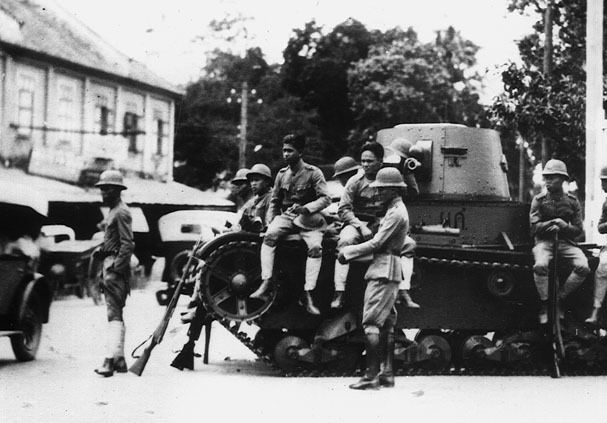| Java Sea: Royal Thai Navy
The Road to Koh Chang, Part One
by Mike Bennighof, Ph.D.
April 2024
 The June 1940 collapse of France left the French still in control of their colonial empire, but with their prestige badly damaged. Some colonies rejected the new government in Vichy and declared their allegiance to Charles de Gaulle’s Free French movement, starting with the New Hebrides in July 1940 with more African and Pacific colonies following. The June 1940 collapse of France left the French still in control of their colonial empire, but with their prestige badly damaged. Some colonies rejected the new government in Vichy and declared their allegiance to Charles de Gaulle’s Free French movement, starting with the New Hebrides in July 1940 with more African and Pacific colonies following.
French Indochina’s colonial government remained true to Vichy, a stance which almost immediately enticed predatory neighbors lusting for control of the colony, or at least a slice of it. No reinforcements would be coming from the home country, and France’s British allies would have no interest in helping defend Vichy. Governor-General Georges Catroux asked the British for help; the price, British Admiral Sir Percy Noble of the China Station told him, would be allegiance to De Gaulle. Should Indochina’s colonial government not rally to the Free French movement and move their small naval squadron to Singapore, Noble noted, the Royal Navy might be ordered to sink them. Catroux declined both demands. Three days after France reached an armistice with Germany, the first Japanese representatives arrived to negotiate French assistance in their war with China. The Vichy government fired Catroux for having spoken with British representatives at all, naming the colony’s naval commander, Vice Admiral Jean Decoux, to replace him. Decoux again approached Noble and begged for a security guarantee; Noble repeated London’s stance.
Following weeks of negotiations, Japanese troops entered northern Viet Nam in September 1940, taking control of three airfields and other key installations, and skirmishing with French Colonial troops, most of whom deserted. The Japanese and the French colonial government reached an agreement allowing the Japanese to use specified French facilities, to station up to 6,000 troops in Indochina, and have up to 24,000 more troops transiting through the colony at any one time. They would eventually demand and receive even more concessions, on top of simply ignoring the agreements when it suited them.

The Franco-Thai non-aggression pact is signed.
Having yielded to Japanese demands, the colonial government next faced pressure from Thailand on the colony’s western border. The French had expanded their holdings during the late 19th and early 20th Centuries through both pressure and open warfare, seizing a large slice of Thai territory. Now that they saw France on the ropes, the Thais wanted their land back.
Seeking to keep Thailand neutral, the French Popular Front government had already agreed in 1939 to return several provinces in modern-day Cambodia to Thailand. The Thais in turn agreed to a non-aggression pact in June 1940, but the armistice with Germany came before the treaty had been signed and the Thais declined to sign with Vichy. The Thais, still seething over their lost lands, now saw their long-time enemies vulnerable.
Marshal Phibul Songkhram, Thailand’s military dictator, ordered mobilization of his 60,000-man army in October 1940. Thai forces were reasonably well-equipped for a minor power, and even fielded tanks where the French had none outside of some ancient FT-17 light tanks, and many more modern aircraft than the French could put into the sky. They also had a more powerful fleet, at least on paper.
Border skirmishes began in November and carried on through December. The French brought up fourteen battalions, most of them Indochinese Colonial troops (Cambodian and Vietnamese). On 5 January 1941 the Thais began their offensive, overrunning most of Laos and driving into Cambodia at multiple points.
The main Thai column, led by tanks, began its advance on 10 January, aiming for the city of Siem Riep – second-largest in Cambodia after the capital Phnom Penh – down Route Coloniale 1 (RC 1, now National Route 6) through the city of Sisophon. Siem Reap (“The Total Defeat of Siam”), site of a legendary and perhaps mythical Cambodian victory over the Thais in the 1550’s, held enormous symbolic significance for the Thais beyond its forced cession to the French in 1907.

Thai tank and soldiers, seen before the war.
The French planned a three-pronged counter-offensive of their own. One ad-hoc brigade would try to recover the parts of Laos lost to the Thais, and another would push up Route Coloniale 1 to meet the Thai column head-on. And the third would be a naval sortie by the Groupe Occasionnel, an ad hoc squadron including all of the useful warships stationed in Indochina, to attack the Thai fleet, known to frequent the roadstead in the Koh Chang Islands off the south-east coast of Thailand close to the border of Indochina. This fleet had not, as yet, played a role in the conflict with the French.
The attack along the upper Mekong in Laos had some success, but it was only a diversion. The main thrust along Route Coloniale 1 turned into a disaster, with a French rout only stemmed by stout resistance from French Foreign Legion anti-tank gunners. It was the naval wing of the operation that would give the French their only victory of the Franco-Thai War. France has not won a sea battle since.
Decoux reached an agreement on 9 December 1940 with the Japanese, in which the Japanese recognized the independence of French armed forces in Indochina and of the colonial government; in exchange, the French permitted the Japanese to make war on China or anyone else from French territory, and raised the number of Japanese troops which could be stationed in the colony to 40,000.
That agreement assured Decoux a free hand to fight the Thai incursions without Japanese interference. Having been promoted out of his naval commander post, Decoux assigned Capt. Régis Bérenger of the light cruiser Lamotte-Picquet to plan and lead the naval phase of the operation. The French naval presence in Indochina consisted of Bérenger’s cruiser, two destroyer-sized modern colonial sloops, and two aging gunboats. On the same day that Decoux signed the pact with the Japanese, 9 December, Bérenger collected his tiny fleet at Cam Ranh Bay and began drilling his crews relentlessly to prepare for action.
The French also began recon flights with their handful of seaplanes, based at Ream on the Cambodian coast. Despite massive Thai air superiority, they managed to confirm that the Thais usually concentrated their ships for the night in the Koh Chang Roads, the closest anchorage to French territory. This natural harbor lay in the center of a ring of small rocky islands, many of them soaring 200 meters above the waterline, with the northern half of the ring formed by Koh Chang Island itself. The roadstead had no facilities and no additional defenses – no minefields, anti-aircraft batteries or coastal defense guns.
The Thais would likely out-number and out-gun Bérenger’s little fleet, but if he could maintain the element of surprise, the French could turn the roadstead into a trap.
You can order Royal Thai Navy right here.
You can order Java Sea right here.
Naval Campaigns
Java Sea: Royal Thai Navy
Java Sea: Wicked Sisters
Coral Sea: Defending Australia
Midway: Rising Sun 1940
Gulf of Aden
Retail Price: $64.95
Package Price: $50.00
Gold Club Price: $40.00
You can order Naval Campaigns right here.
Sign up for our newsletter right here. Your info will never be sold or transferred; we'll just use it to update you on new games and new offers.
Mike Bennighof is president of Avalanche Press and holds a doctorate in history from Emory University. A Fulbright Scholar and NASA Journalist in Space finalist, he has published a great many books, games and articles on historical subjects; people are saying that some of them are actually good.
He lives in Birmingham, Alabama with his wife, three children, and new puppy. He misses his lizard-hunting Iron Dog, Leopold.
Want to keep Daily Content free of third-party ads? You can send us some love (and cash) through this link right here.
|
